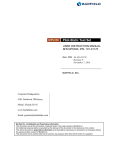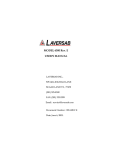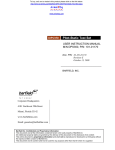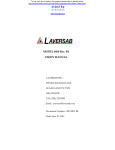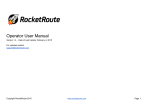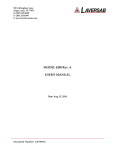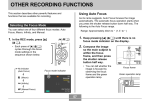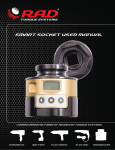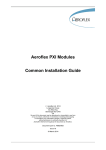Download PS-425 User Manual
Transcript
PS-425 Pitot-Static/Air Data Tester OPERATION AND MAINTENANCE MANUAL Preston Pressure LLC prestonpressure.com Revision 2, November 1, 2013 PRESTON PRESSURE LLC PS-425 USER AND MAINTENANCE MANUAL TABLE OF CONTENTS Page Warranty and Liability Statement---------------------------------------------------- 2 1. General Information------------------------------------------------------------------2. Specifications -----------------------------------------------------------------3. Front Panel Layout------------------------------------------------------------4. Front Panel Description ------------------------------------------------------- 3 4 5 6 2. Theory------------------------------------------------------------------------------------- 7 3. Operation -------------------------------------------------------------------------------- 8 1. Preliminary Information ------------------------------------------------------- 8 2. Error Codes --------------------------------------------------------------------8 2. Pre-testing ----------------------------------------------------------------------- 8 3. Testing Aircraft Pitot System ------------------------------------------------- 9 4. Testing Aircraft Static System ----------------------------------------------10 5. Testing the Aircraft Pitot and Static systems simultaneously --------- 10 4. Calibration Procedures ---------------------------------------------------------------- 12 1. Altimeter Calibration ---------------------------------------------------------- 12 2. Airspeed Calibration ----------------------------------------------------------- 15 5. Maintenance Repairs and Troubleshooting --------------------------------------- 16 1. Annual Maintenance ----------------------------------------------------------- 16 2. Troubleshooting ---------------------------------------------------------------- 16 6. Shipping and Storage ------------------------------------------------------------------ 18 1 WARRANTY AND LIABILITY STATEMENT Preston Pressure LLC warrants its products against defects in workmanship and material under normal, intended use for a period of two years from the date of purchase. Valves are warranted for a period of 180 days. Preston Pressure’s limit of liability shall be to repair or replace the product at their discretion. Transportation shall be pre-paid to the Preston Pressure factory or authorized service facility. Preston Pressure shall not be liable for any consequential damage expense. This warranty shall be void if the product has been repaired or altered in any way that adversely affects its performance or reliability. This warranty shall be void if the product has been subject to abuse, misuse, contamination, negligence, accident, shipping damage, or improper operation. Preston Pressure reserves the right, at its own discretion, to make changes in materials, designs, finish, or specifications, without obligation to install or incorporate such changes in products previously manufactured. This warranty shall, at Preston Pressure’s option, become void if the ownership is changed, unless the prior owner or proposed owner obtains written approval of continuation of coverage prior to the change of ownership. Preston Pressure reserves the right to revise this manual and to make changes to content from time to time in the content thereof, without obligation to notify any person of such revision. This device complies with part 15 of the FCC Rules. Operation is subject to the following two conditions: (1) This device may not cause harmful interference, and (2) this device must accept any interference received, including interference that may cause undesired operation. 2 CHAPTER 1 GENERAL INFORMATION Description of the PS-425 Pitot-Static Test Box The PS-425 Air Data, pitot-static test box is a digital display tester used to test aircraft altimeters, airspeed indicators, pitot-static systems, and other vacuum and low-pressure devices. This test box incorporates transducer sensor technology that is largely immune to the failures and costly repairs associated with analog instruments. The PS-425 incorporates a digital instrument model TST-621. Altitude is displayed in feet, with increments of 2 and 5 feet. Airspeed is displayed in knots. Vertical speed is indicated in feet per minute. The PS-425 is powered by 8 D-size alkaline batteries or an external power adapter. The vacuum and pressure sources are derived from independent manual pumps, and each pump has its own reservoir, thus eliminating the complexity and maintenance of an additional pressure/vacuum selector valve. The tester can simulate pressure and vacuum suitable for up to 35K ft and 500 Knots. 3 PS-425 SPECIFICATIONS Digital Altimeter: Display Range : -1000 to 35,000 feet Vacuum Pump Range: -1000 to 35,000 feet Resolution: from -1,000 to 30,000 feet resolution is in 2-feet increments from 30,000 to 35,000 feet resolution is in 5-feet increments Sensor Accuracy: approximately 0.03 % Temperature range: 32 degrees F to 120 degrees F (0 C to 50 C) Altitude units: Feet Digital Airspeed: Range: 18 – 500 Knots Resolution: 1 Knot Sensor Accuracy: 0.03% Temperature range: 32 degrees F to 120 degrees F (0 C to 50 C) Physical Dimensions: 12.25”D X 15”L X 9.75”H (31x38x24.5 cm) Weight: approximately 17.1 lbs (7.7 Kg) Power Source: External: 12 VDC (from a 110/220 VAC adaptor or other source) Internal: 12 VDC (from internal alkaline batteries) Current draw: 100 mA with backlight on, 10 mA with backlight off Other Features: Leak test feature: 2 minutes, selectable down to 30 seconds (longer test periods available upon request) VSI (vertical speed indicator) : Increments of 2 when < 100 feet/minute; increments of 10 when > 100 feet/minute. Note: The PS-425 does NOT have the precision required to test RVSM altimeter systems. 4 FRONT PANEL LAYOUT 5 Front Panel Description The UNITS button is used to toggle between the two primary display modes. Upon powering up, the display indicates altitude in feet and airspeed in knots. Pressing the UNITS button will switch the display to indicate altitude in feet and vertical speed per minutes in feet. Pressing the UNITS button again will toggle back to the original display. The LEAK CHECK will begin a 120 second timer, and the display will also show the gain or loss of altitude or airspeed experienced during the displayed time period. If the Leak Check button is pressed while in the altitude/airspeed mode, the leak check will enter the airspeed leak test mode. If the Leak Check button is pressed while in the altitude/VSI mode, the leak check will enter the altitude leak test mode. If the operator wishes to select a different length of testing time, the Leak Check button may be pressed repeatedly, which will cause a reduction in the timer counter in 30second increments. The timer will not toggle above 120 seconds nor under 30 seconds. Once the time is selected, press the Units button to start the timer. The EXIT button is used to exit out of the leak check mode. The LIGHT button will toggle the display backlight ON or OFF. Altitude - The altitude is measured based on a reference point of 29.92 (sea level). This is pre-set at calibration and cannot be changed by the operator. The altitude is displayed in increments of 2 feet up to 30,000 feet, and 5 feet at altitudes above 30,000 feet. Airspeed – The airspeed is calculated based on the pressure differential between the static sensor and the pressure sensor. The two sensors are identical but independent. A pressure difference between the two sensors will not cause damage, even if they are at a high vacuum on one sensor and a high pressure on the other. (Either sensor may be damaged if its pressure exceeds 20 psi.) If the pitot pressure is lower than the static pressure, the airspeed reading will show “InverseP”. An inverted pressure situation will not damage the TST-621 instrument, but it may damage instruments in the aircraft! If the airspeed exceeds 500 knots, or if the altitude range exceeds 36,000 feet, the airspeed display will indicate “Hi Alt ” or “High Kts”. This condition will not damage the TST-621 instrument, but the display serves to indicate that the pressure differential has exceeded the altitude or airspeed calculations. 6 CHAPTER 2 THEORY The PS-425 test box consists of one manual vacuum pump, one manual pressure pump, reservoirs for the pressure and vacuum, and a digital display for indicating altitude and airspeed. • Pneumatic Theory Metering valves allow the operator to control the rate of flow of the air from the pressure or vacuum sources, exiting out through the vacuum and pressure ports. The vent valves allow for metering the produced vacuum or pressure back into the atmosphere. One crossbleed valve permits the operator to isolate the pressure and vacuum sides, or to allow the balancing of pressures, or even to reverse the normal “flow” of pressure. The two round gauges allow the operator to monitor the level of pressure or vacuum that is stored in the tester’s reservoirs. When the operator wishes to simulate an altitude, the Crossbleed, Vacuum, and Vacuum Vent valves are gently closed. The vacuum cylinder is pumped until sufficient vacuum is in the reservoir, as indicated on the Vacuum Reservoir Gauge. How much vacuum will be needed depends on the desired altitude, and is also affected by how long the tubing and lines are between the test box and the altimeter. The vacuum and pressure reservoir gauges serve only as general references of reservoir vacuum and pressure; they are not used in the actual calibration of any instrumentation, and do not require calibration. Once sufficient vacuum is obtained in the reservoir, the Vacuum Valve is gently opened to allow air to be suctioned into the system through the vacuum port. Once sufficient altitude simulation is obtained, the Vacuum Valve is gently closed. Reduction in altitude is accomplished by gently opening the Vacuum Vent Valve, and allowing atmospheric air pressure to enter into the lines. If the operator needs to go to an altitude below atmospheric pressure, pressure must be introduced into the pressure reservoir. Opening the Crossbleed Valve will enable pressure to flow from the pressure reservoir to the altimeter. Open the Crossbleed valve, and then the Pressure valve to pressurize the vacuum side. Similarly, when airspeed is to be simulated, the Crossbleed, Pressure and Pressure Vent valves will first be closed, until the operator establishes a pressure build-up in the pressure reservoir by pumping the pressure cylinder. Then the Pressure Valve will be gently opened, allowing air pressure to flow through the pressure port to the airspeed indicator. To reduce pressure, the Pressure Vent valve is opened to leak the air pressure into the atmosphere. 7 CHAPTER 3 OPERATION • Preliminary Information Prior to using the PS-425 tester, the user should become familiar with the unit by reading this manual and operating the tester independently of any other attached devices. For greater accuracy, the indicator should be powered on for 15 minutes before use. The test procedures described in this manual are general in nature, for reference use only. The operator may substitute these procedures with others, as applicable to the tests to be performed, the aircraft to be checked, or according to other documentation. Error codes display as follows: • The display will blink if altitude exceeds 35,200 feet, or if sensor temperature is below 32F or 0C, or above 122F or 50C. Beyond these limits the accuracy should not be trusted. • Altitude displays “Hi Alt” if it exceeds 40,000 feet. • “InverseP” will be indicated on the airspeed side if the static pressure exceeds the pitot pressure by more than approximately 0.1 mbar. Due to its independent pressure and static sensors, no damage will occur to the tester due to inverse pressure. However, damage could occur to any system attached to the tester, therefore the warning is to alert the user of the condition. • “High Kts” will be indicated on the airspeed side if the pressure exceeds the equivalent of 500 knots. Due to independent pressure and static sensors, no damage will occur to the tester due to this condition. However, damage could occur to any system attached to the tester, therefore the warning is to alert the user of the condition. Be very gentle with the precision metering valves. Do not close these valves with unnecessary force, or internal damage to valve seating will occur. Normally, the valves are closed when the operator senses resistance near the bottom of the internal stem travel. Repeated over-torqueing of the valve will eventually cause damage to the valve seat. • Pre-Testing Pre-test the static system of the PS-425 test box according to the following steps: 1. Ensure the PS-425 is not connected to any external hoses or devices. 2. Close the Vacuum Control, Vacuum Vent, Crossbleed, Pressure Control, and Pressure Vent valves. 8 3. Turn on the power, and then actuate the Vacuum Pump until the Vacuum Reservoir gauge reads approximately -15 inHG. 4. Gently open the Vacuum Control valve to make the Altimeter section climb. This climb may be done rapidly without damage to the sensor. 5. When the Altimeter reads at least 18,000 feet, gently close the Vacuum Control valve. 6. Wait for about 60 seconds for internal pressures to stabilize. Then perform a leak check. 7. The leak check function will activate and begin to monitor the leak rate. Verify that the PS-425 does not leak exceeding 100 feet per minute. Write down the leak rate for future reference. (Subtract this value from the total leak rate when testing the aircraft, to arrive at the aircraft’s leak rate.) 8. Gently open the Vacuum Vent valve to bring the test box back to ground (ambient) pressure. Pre-test the pressure system of the PS-425 test box according to the following steps: 1. Turn on the power to the PS-425. 2. Ensure the PS-425 is not connected to any external hoses or devices. 3. Close the Vacuum Control, Vacuum Vent, Pressure Control, Crossbleed valve, and Pressure Vent valves. 4. Actuate the Pressure Pump until the Pressure Reservoir gauge reads approximately 10 - 15 PSI. 5. Gently open the Pressure Control valve to make the Airspeed section climb. This climb may be done rapidly without damage to the sensor. 6. When the Airspeed reads at least 300 knots, gently close the Pressure Control valve. 7. Wait for about 30 seconds for internal pressures to stabilize. Activate the leak check function to monitor the leak rate. Verify that the PS-425 does not leak exceeding 2 knots per minute. Write down the leak rate for future reference. (Subtract this value from the total leak rate when testing the aircraft, to arrive at the aircraft’s leak rate.) 8. Gently open the Pressure Vent valve to bring the test box back to ground (ambient) pressure. Testing Aircraft Pitot System Only 1. Turn on the power to the PS-425. 2. Connect the Pressure Port to the aircraft Pitot system. 3. Close Pressure Control, Pressure Vent, and Crossbleed valves. Open Vacuum vent valve. 4. Actuate the Pressure Pump until the Pressure Reservoir indicates 10 - 15 PSI or more. 5. Gently open Pressure Control valve until desired speed(s) are achieved. 6. Compare the airspeed of the PS-425 box to the airspeed indicated in the aircraft. 9 7. Go to approximately 75% of the maximum airspeed of aircraft indicator (or the speed specified by the manufacturer). Close the Pressure Control valve and after allowing a few seconds for stabilization, perform a leak check. The pitot system should not leak more than two knots per second, plus the leakage previously noted in the pressure system pre-test. 8. Gently open the Pressure Vent valve to return the pitot pressure to ambient pressure. Testing of Aircraft Static System Note: If the previous pitot system test indicated an excessive leak, do not proceed until that leak is repaired. Damage to aircraft airspeed indicator could result. 1. Turn on the power to the PS-425. 2. Connect the Vacuum Port to the aircraft static port, and the Pressure Port to the aircraft pitot port. Set the aircraft altimeter to 29.92 inHg. 3. Close Vacuum Control, Vacuum Vent, Pressure Control, and Pressure Vent valves. Open Crossbleed valve. 4. Actuate the Vacuum Pump until a desired level of vacuum is seen on the Vacuum Reservoir gauge (generally -15 to -20 inHG). Actuate the Pressure Pump until the Pressure Reservoir indicates 10 - 15 PSI or more. 5. Gently open the Vacuum Control valve to cause the altitude to climb. 6. DO NOT exceed the climb rate of the aircraft VSI indicator, or the airspeed indicator limits. The VSI is a very delicate instrument. 7. Climb to the desired altitude(s) per the test to be performed. 8. Close the Vacuum Control valve, and after allowing a few seconds for stabilization, compare the aircraft altimeter with the test box. 9. When at the appropriate altitude (generally 18,000 feet) perform a leak check. If the static system shows leakage, be careful to not exceed the VSI rate. Be prepared to open the Vacuum Control valve if needed, to prevent excessive VSI indication. 10. Gently open the Pressure Vent valve to return the system pressure to ambient pressure. Do not exceed the VSI or airspeed indicator limits. Note: if an altitude lower than ambient pressure is desired, do steps 1-4 above. Gently open the Pressure Control valve to pressurize the system, thereby causing the altimeter to decrease in altitude. Open the Vacuum Vent valve to return to ambient pressure. Testing the Aircraft Pitot and Static systems simultaneously Note: First ensure pitot system does not leak by performing Pitot system test on page 14. 1. Turn on the power to the PS-425. 2. Connect the Vacuum Port to the aircraft static port, and the Pressure Port to the aircraft pitot port. Set the aircraft altimeter to 29.92 inHg (1013.3 mbar). 10 3. Close Vacuum Control, Vacuum Vent, Pressure Control, and Pressure Vent valves. Open Crossbleed valve. 4. Actuate the Vacuum Pump until a desired level of vacuum is seen on the Vacuum Reservoir gauge (generally -15 to -20 inHG). Actuate the Pressure Pump until the Pressure Reservoir indicates 10 - 15 PSI or more. 5. Gently open the Vacuum Control valve to cause the altitude to climb. 6. DO NOT exceed the climb rate of the aircraft VSI indicator, or the airspeed indicator limits. The VSI is a very delicate instrument. 7. Climb to the desired altitude(s) per the test to be performed. 8. Close the Vacuum Control valve, and after allowing a few seconds for stabilization, compare the aircraft altimeter with the test box. 9. When at the appropriate altitude (generally 18,000 feet) perform a leak check. If the static system shows leakage, be careful to not exceed the VSI rate. Be prepared to open the Vacuum Control valve if needed, to prevent excessive VSI indication. 10. To display an airspeed, close Crossbleed valve and gently open Pressure valve until desired airspeed is indicated. Close Pressure valve. 11. To return system to ambient pressure, ensure Crossbleed valve is open. Then gently open the Pressure Vent valve to return the system pressure to ambient pressure. Do not exceed the VSI or airspeed indicator limits. Note: if an altitude lower than ambient pressure is desired, do steps 1-4 above. Gently open the Pressure Control valve to pressurize the system, thereby causing the altimeter to decrease in altitude. Open the Vacuum Vent valve to return to ambient pressure. 11 CHAPTER 4 CALIBRATION PROCEDURES The recommended calibration interval for the PS-425 is one year. If at any time during regular use the unit becomes unreliable or out of correct operating calibration, it must be repaired and/or re-calibrated before continuing its use. The PS-425 is easy to calibrate. There are 5 set points used in the calibration of the altimeter. This enables the altimeter to have a greater degree of accuracy, allowing it to self-correct to the nearest calibrated set point. The calibration factors are stored in the microcontroller’s EEPROM memory and does not need battery back-up. The calibration will not be lost when power is removed. Altimeter Calibration Procedures 1. Apply power to the PS-425 and allow a warm up for a minimum of 15 minutes. 2. Connect a known altitude pressure standard to the Static and Pitot ports, (both ports connected together, sensing the same pressure). 3. Press the Exit and Leak Check buttons simultaneously. The display will change to: Cal? No Yes 4. Press the Leak Check button to proceed with calibration, or press the Exit button to exit out of the calibration mode without any changes being made. 5. At this point the display will read: Goto 0 Feet This is to notify the technician that the current calibration point is 0 feet (29.92 inHg). To select a different calibration point, press the backlight button (the button will not activate the light while in Cal mode). There are 5 calibration points: 0, 10,000, 20,000, 30,000, 40,000 feet. When the desired calibration point is displayed, press the Units button. The first calibration point display will read: Pt Altitude (Pitot sensor, altitude in feet) In xxx 12 The letters Pt indicates that the sensor being calibrated in this step is the Pitot sensor. (Where Altitude is the sensed altitude in feet, and xxx is the current calibration value.) Write down the calibration value so it can be re-set if needed! The word “In” is displayed above the Units button. Press the Units button when ready to input the selected correction value. This step finishes the pitot side calibration. 6. Go to a pressure that corresponds to the selected calibration point (referenced from 29.92 inHg), as read from a pressure standard. When the altitude is stable for approximately 15 seconds, note the altitude displayed on the PS-425 display in calibration mode. If the displayed altitude is lower than the standard, press the Exit button as needed to incrementally raise the altitude to be equivalent to the standard. If the displayed altitude is higher than the standard, press the Leak Check button as needed to incrementally lower the altitude to be equivalent to the standard. As the altitude is adjusted, note that the displayed correction factor also changes, and the change is in increments smaller than the altitude. Use this to fine-tune the altitude as close as you can to the standard. When the PS-425 altitude matches the standard as close as possible, wait another 30 seconds to ensure that the internal mathematical filtering corrections have been done. If satisfied with the results, press the Units button to Input the selected correction, and the display will automatically proceed to the next calibration level. 7. Repeat the procedure in step 7 at each requested altitude: 10000, 20000, 30000 and 40000 feet as needed. 8. After entering the calibration value of the highest altitude, pressing the Units button will change the calibration to the VSI calibration mode. Select a vertical descent speed (5,000 feet is suggested) on the calibration test equipment and activate it. The TST-621 will indicate the calculated VSI value. Adjust if needed by pressing the Exit or Leak Check buttons. When finished, press the Units button. The VSI calibration value will be saved. 9. After the VSI calibration has been entered, the display will briefly read “Finished Cal” and then re-start. There is no need to re-cycle power. 10. After bringing the PS-425 back down to ground level pressure, wait at least 10 minutes for settling. Then, test each calibration point as specified in the chart on page 14. Enter the corrected value at each point. (The correction chart may be photocopied, cut out, and fixed to the test box for handy reference.) 13 Helpful Notes: When the display is indicating “Go To XX Feet”, pressing the Light button will cycle through the various calibration points of 0, 10,000, 20,000 feet, etc. After 40,000 feet it will exit the calibration mode. This is handy for use in those cases when only one range is in need of calibration. Note, however, that the PS-425 unit’s pressure must be within less than 2,500 feet of the selected range in order to save the new value. This eliminates accidentally saving a value when in an incorrect pressure range. Note: Allowable error tolerances are as follows: Altitude +/-Error Altitude -1000 5 14000 0 5 16000 500 5 18000 1000 5 20000 1500 6 22000 2000 7 25000 3000 7 30000 4000 8 35000 6000 10 8000 15 10000 20 12000 22 PS-425 S/N FOR TEST DISPLAY FOR TEST ALTITUDE ALTITUDE ALTITUDE - 1000 10000 0 12000 500 14000 1000 16000 1500 18000 2000 20000 3000 22000 4000 25000 6000 30000 8000 35000 Cal Date: Expires: +/-Error 25 27 30 32 35 38 45 51 DISPLAY ALTITUDE Original Calibration Correction Values (for reference during calibration): Calibration Point 0 Ft 10,000 Ft 20,000 Ft 30,000 Ft 40,000 Ft Correction value 14 Airspeed Calibration Procedures 1. Perform the altimeter calibration described in the previous section. The pitot sensor is calibrated in this process, along with the static sensor. 2. When a satisfactory altitude calibration is obtained, go through each test point in the following chart, and enter the corrected value at each point. (The correction chart may be photocopied, cut out, and fixed to the test box for handy reference.) Note: if the airspeed calibration needs additional adjustment after being calibrated in the altitude calibration procedures, the adjustment can be done by entering the calibration process described in steps 1-6 of the previous section. Then adjust only the Pt sensor up or down to increase or decrease the calibration point. Press the Units button to store the change. Repeat as needed to achieve the desired correction. (Adjusting the Pt calibration will not change the calibration for the Static sensor, which senses altitude.) TEST DISPLAY TEST DISPLAY AIRSPEED AIRSPEED AIRSPEED AIRSPEED 40 Kts 250 Kts 60 Kts 275 Kts 80 Kts 300 Kts 100 Kts 325 Kts 120 Kts 350 Kts 140 Kts 375 Kts 160 Kts 400 Kts 180 Kts 425 Kts 200 Kts 450 Kts 225 Kts 500 Kts Calibrated by: ___________ Date: ________________ Next Calibration Due Date: ______________________ Original Calibration Correction Value (for reference during calibration): 15 CHAPTER 5 MAINTENANCE REPAIRS AND TROUBLESHOOTING Note: Refer to the Theory of Operation section as a reference on how the various systems function. Annual Maintenance The following annual maintenance is recommended: 1. Check color of beads in air reservoir/dryer. Change if pink or clear. The dryer is a common in-line dryer used in small air compressor systems. A new dryer can be purchased from Preston Pressure, or an internet search for “mini inline desiccant air dryer” may lead to an alternate source. 3. Verify batteries are fresh. Avoid old batteries that may leak and corrode the battery contacts. 4. Verify vacuum reservoir tank is mounted tightly. 5. Verify pump cylinders are tight. 6. Verify switches and valves on front panel are mounted tightly. 8. Test for leaks. 9. Perform calibration checks, and re-calibrate if necessary. • Troubleshooting Refer to the following chart of symptoms, causes, and repair comments: SYMPTOMS Display shows garbage or freezes at the beginning display. Display never initializing POSSIBLE CAUSES Microcontroller had a power brown-out or there is a low voltage condition. COMMENTARY 1.Turn off unit for 15 seconds before powering up again. 2. Re-cycle power switch. If problem occurs frequently, it may be caused by a corroded switch. Also check battery contacts. finishes 1. Tester is being operated 1. Operate the tester in a in conditions that are warmer environment. 16 excessively cold. 2. Low battery Unit will not vacuum up to 1. Leak in internal hoses or 35,000 feet plumbing connectors 2. Cylinder pump is weak or inoperative 1. Troubleshoot plumbing to find leak(s) 2. Replace defective cylinder Removal of rear fittings may damage the indicator! If a rear fitting seems to be too tight, and there is danger of damaging the plastic case, follow these instructions to prevent irreversible damage to the indicator: 1. Disconnect power and external tubing, and remove indicator from test unit. 2. Remove front keypad panel. (Some older units have this panel glued in place. If this is the case, carefully cut around the top and bottom keypad edges, then insert a thin prying knife, and gently pry top panel until released.) 3. Remove small screws on display, then pull out electronic circuits. 4. Remove small screws used on power connector. 5. Disconnect internal tubing (mark tubes to match with fittings for reassembly). 6. Use deep socket wrench to hold internal fitting while removing rear fitting. 7. Reassemble indicator. (Note: the screws for the power connector are longer than the screws for the display.) Internal view of indicator, showing fittings. 17 CHAPTER 6 SHIPPING AND STORAGE Shipping Instructions • • • • Partially open all valves Ensure power switch is off Package the test box inside another box, with at least 2 inches of packing material around the tester Tester is not likely to be damaged with ground shipping if packaged properly Storage Instructions • • • • Partially open all valves Place lid on tester Store the test set in a controlled environment If storage is to exceed 1 year, remove batteries from unit 18





















